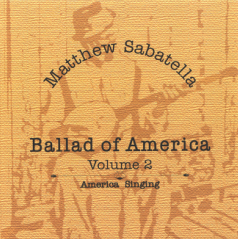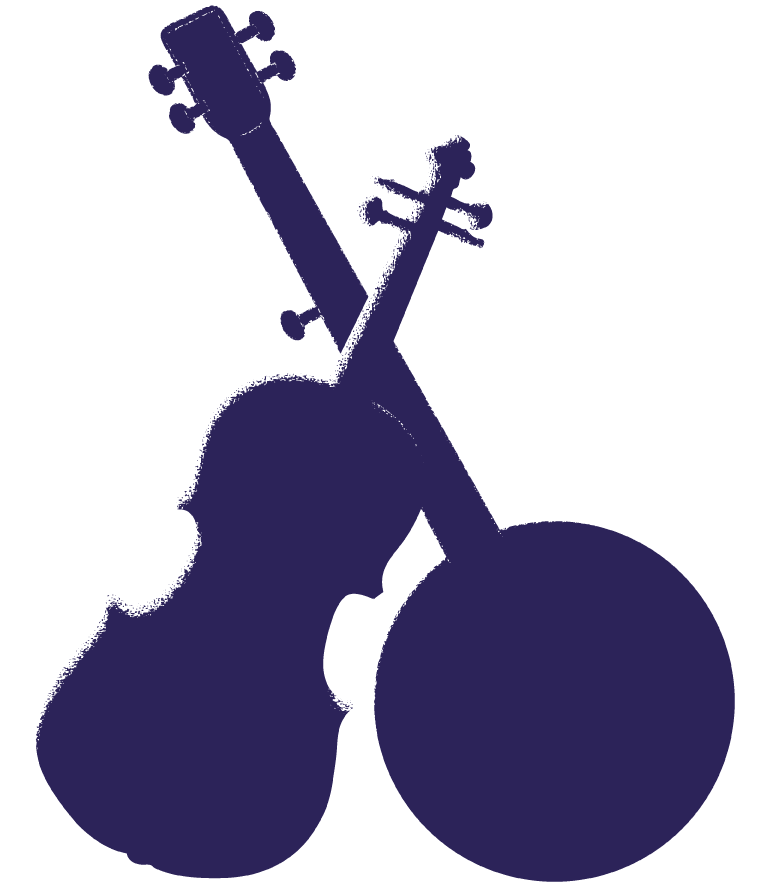

Overview
This is the second album in the Ballad of America series, which tells the story of the United States through traditional folk songs. It features sixteen of the all-time greatest American folk songs. These are songs that are, or should be, well-known to every American.
The songs in this collection are among the most commonly sung in the history of the United States. They present uniquely American musical blends, with roots in European and African traditions and branches that have sprouted countless regional and personal variants throughout the country. Collectively, these songs of work, fun, and love transcend social and ethnic boundaries, painting a broad picture of America during the 18th and 19th centuries when music making was, for many, an integral part of everyday life.
The compact disc includes a booklet containing historical background for each song (reprinted below).
Streaming
Apple Music
Spotify
YouTube
Reviews
The arrangements are fresh but traditional, the singing is great, and each track comes with historical notes.
Rick Anderson – Baker & Taylor’s CD HotList
He’s recasting traditional tunes… in faithful, well-worn renditions that probably sound much like they did originally, when early settlers making their way west across the open prairies spilled forth the tunes over old-fashioned campfires.
Lee Zimmerman – New Times
Sabatella’s best asset is easily his voice, urgent but unforced, sweetly melancholy in telling personal stories and powerfully evocative in rendering antiquated songs intimate again. It’s a great gift, and Sabatella wields it with exceptional talent.
“Best Acoustic Performer” – New Times “Best of” Issue
Album Notes
Click the song title to visit the Ballad of America page with lyrics, more information, and streaming links.
1. Wabash Cannonball
The Lake Erie, Wabash, and St. Louis Railroad Company was formed in 1852. There was, however, no train named the “Cannonball” when this song was first sung late in the 19th century. The anonymous hobos who made the song up may have been paying homage to a specific train, or to a “mythical train that runs everywhere,” as suggested by George Milburn in The Hobo’s Hornbook.
2. Go Tell Aunt Rhody
This may have originated as a play-party song during New England’s colonial days. Most Protestant communities had restrictions against dancing and playing musical instruments. Play parties were designed to sidestep those restrictions by using only handclaps for accompaniment and the simple patterns of children’s games to replace the intricate patterns of country dances. Depending on the locale in which this song was sung, the aunt may have had a name such as Patsy, Dinah, or Nancy.
3. Skip to My Lou
In frontier communities throughout the country, young and old alike skipped, marched, clapped, and swung each other by the hand to this play-party song.
4. Buffalo Gal
As it was originally published in 1844, the song Lubly Fan beckoned a young woman of that name to come out and dance. Although credited to Cool White, the stage name of blackface minstrel John Hodges, it was most likely adapted from other song sources. The words were frequently localized as the popular song moved about the United States with traveling minstrel troupes: Charleston Gals, Bowery Gals, New York Gals, and Philadelphia Gals. By 1848, Buffalo Gals had become the preferred version.
5. Blue Tail Fly
Although blackface minstrel shows relied heavily on negative racial characterizations, this minstrel song has an abolitionist attitude. It is usually associated with Dan Emmett, but was credited when published in 1846 to F.D. Benteen. A supposed favorite of Abraham Lincoln, the song reflects the hostility of slave towards master in Southern plantation society.
6. Oh Susanna!
Stephen Foster was only 21 years old when he composed this song, and he later wrote, “the two fifty-dollar bills I received [for Oh Susanna!] had the effect of starting me on my present vocation as a songwriter.” In his 37 years of life, Foster wrote more than 200 songs. He visited the South only once, yet many of his songs portrayed blacks and slave life and were frequently performed by blackface minstrel singers. Oh Susanna! was beloved by ‘49ers during the California gold rush, helping it to become the most popular song in America.
7. On Top Of Old Smokey
The roots of this song stretch across the Atlantic Ocean to England, perhaps as long ago as the 16th century. Its branches include many other folk songs with similar lyrical stanzas and tunes. A lonesome love song, it has frequently been sung high in the Appalachian Mountains for courting.
8. Bile Them Cabbage Down
“Bile” is a phonetic writing of the word “boil.” A hoecake is a thin, flat cake made from cornmeal, originally baked on a hoe. According to some, this tune can be traced to an English country dance called Smiling Polly, first printed in 1765. As it has been played and sung throughout the South, the song integrates African and European musical elements: banjo and fiddle – slave, minstrel and mountaineer.
9. Down in the Valley
This is another popular Appalachian Mountain courting song that descended from a British air.
10. Pick a Bale Of Cotton
During the time of slavery and beyond, work on the Southern plantation was often enlivened by the singing of work songs. Singing moved the work along faster and made the physical labor and drudgery a little easier to bear. A bale of cotton weighs 500 pounds, which is more than anyone could really pick in a single day.
11. I’ve Been Working on the Railroad
This song was adapted late in the 19th century either from an African-American spiritual about working on a Mississippi River levee or from an old Irish hymn. Someone’s in the Kitchen with Dinah was a separate song that was later tagged onto the end.
12. Red River Valley
Originally sung in New York State as The Bright Mohawk Valley, by the 1880s this song had settled in the West as Red River Valley.
13. Crawdad Song
This song evolved from Anglo-American play-party traditions and African-American blues. Workers building levees to prevent the flooding of the Mississippi River in the South were among the first to sing it.
14. Old Blue
In 19th century America, hunting was a way of life for many people who relied on game for food. From somewhere in the Mississippi Valley came this sentimental tribute to a beloved hunting dog.
15. Billy Barlow
An old English version of this Southwestern ballad describes a quintet shooting a cutty wren with bows and arrows. It was a song of protest by the hungry British peasantry. In most American versions, a squirrel, rat, or other small animal replaces the cutty wren.
16. Home on the Range
The words to this song were published in several newspapers during the 1870s, credited to Dr. Higley Brewster of Smith County, Kansas. The tune was allegedly composed by Daniel E. Kelly. Other claims set the origin of the song to an earlier time. It became hugely popular throughout the English-speaking world in the first half of the twentieth century.
